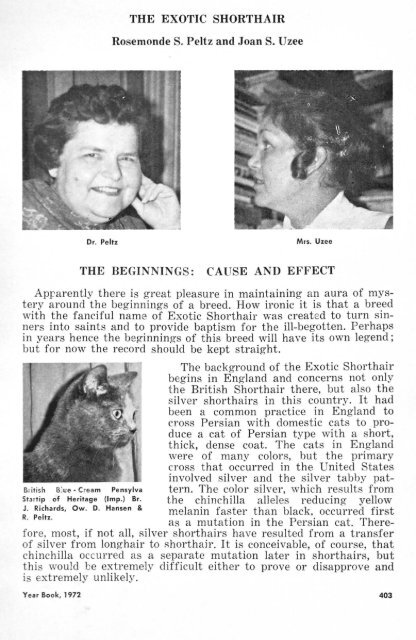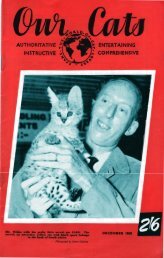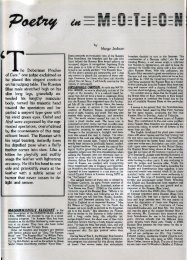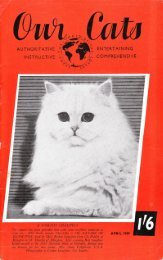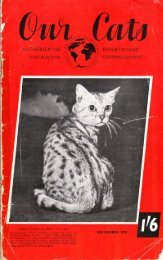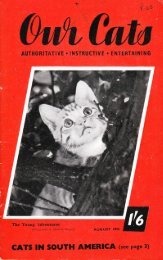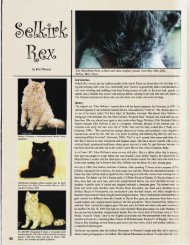The Exotic Shorthair - Kyina & Talisker Cats Breeders of Russian ...
The Exotic Shorthair - Kyina & Talisker Cats Breeders of Russian ...
The Exotic Shorthair - Kyina & Talisker Cats Breeders of Russian ...
Create successful ePaper yourself
Turn your PDF publications into a flip-book with our unique Google optimized e-Paper software.
THE EXOTIC SHORTHAIRRosemonde S. Peltz and Joan S. UzeeTHE BEGINNINGS: CAUSE AND EFFECTApparently there is great pleasure in maintaining an aura <strong>of</strong> mysteryaround the beginnings <strong>of</strong> a breed. How ironic it is that a breedwith the fanciful name <strong>of</strong> <strong>Exotic</strong> <strong>Shorthair</strong> was created to turn sinnersinto saints and to provide baptism for the ill-begotten. Perhapsin years hence the beginnings <strong>of</strong> this breed will have its own legend;but for now the record should be kept straight.<strong>The</strong> background <strong>of</strong> the <strong>Exotic</strong> <strong>Shorthair</strong>begins in England and concerns not onlythe British <strong>Shorthair</strong> there, but also thesilver shorthairs in this country. It hadbeen a common practice in England tocross Persian with domestic cats to producea cat <strong>of</strong> Persian type with a short,thick, dense coat. <strong>The</strong> cats in Englandwere <strong>of</strong> many colors, but the primarycross that occurred in the United Statesinvolved silver and the silver tabby patitishBlue. Cream Pensylva tern. <strong>The</strong> color silver, which results fromSt3:tip <strong>of</strong> Heritage (Imp.) Br. the chinchilla alleles reducing yellowJ. Richards, Ow. D. Hansen &melanin faster than black, occurred firstR. Peitz.as a mutation in the Persian cat. <strong>The</strong>refore,most, if not all, silver shorthairs have resulted from a transfer<strong>of</strong> silver from longhair to shorthair. It is conceivable, <strong>of</strong> course, thatchinchilla occurred as a separate mutation later in shorthairs, butthis would be extremely difficult either to prove or disapprove andis extremely unlikely.Year Book, 1972 403
<strong>The</strong> practice <strong>of</strong> crossing Persian to Domestic <strong>Shorthair</strong> was quiteprevalent in the 1950's and continues to this day. At that time, theDomestic <strong>Shorthair</strong>, later called American <strong>Shorthair</strong>, was neither ashorthair nor did it resemble the hardcoated, sleek, hearthside cat <strong>of</strong> our homes.<strong>The</strong> naivete <strong>of</strong> novice as well as experiencedbreeder was taxed considerably forthese very beautiful cats received greatacclaim in the show ring as American<strong>Shorthair</strong>s. As in the Emperors NewClothes, judges, breeders and the fancyturned blind eyes toward these cats andeither refused to see or could not admitwhat they truly saw. <strong>The</strong> questioningsPensylva full face; showing shortmuzzle and blaze.and murmurings <strong>of</strong> the unindoctrinatedwere muffled for a time. <strong>The</strong>re were those,who at the beginning, thought that thesecats were, indeed, true American <strong>Shorthair</strong>s fancified to exceptionalbeauty. Yet those breeders, who could in no way reconcile what theysaw with what they believed to be true, began seeking answers. Because<strong>of</strong> their integrity, certain breeders frankly admitted the practice<strong>of</strong> hybridizing. Much credit is due them for the amazing catsthey produced. It is a difficult feat in the Persian-American <strong>Shorthair</strong>cross to achieve proper coat and tabby pattern in the same cat.Interestingly enough, other breeders were unaware <strong>of</strong> the heritage <strong>of</strong>their cats. <strong>The</strong>y accepted pedigrees at face value and felt that silverwas a natural shorthair color. <strong>The</strong> practice <strong>of</strong> crossing Persian toshorthair continued and was soon to become legitimate.In 1966 Mrs. Jane Martinke suggested a program for hybrid recognition,one part <strong>of</strong> which provided a place for chinchilla and shadedsilver American <strong>Shorthair</strong>s. This new "breed" was to be called Sterling<strong>Shorthair</strong>s. (1) In spite <strong>of</strong> the honorable intentions <strong>of</strong> this programGrayfire's Cheyenne — Owner: Doris Walkingstick404 C.F.A.
to set things straight, it was not met with unbridled enthusiasm.Why should breeders <strong>of</strong> these cats suddenly transfer them to a hybridclass ? For years the judges had obviously sanctioned their catsas American <strong>Shorthair</strong>s.<strong>The</strong> matter was pursued by Mrs. Martinke, and in September, 1966,through Mrs. Jean Rose, she suggested that "a hybrid class for Domestics<strong>of</strong> mixed Persian and American <strong>Shorthair</strong> parentage" beestablished to be called "<strong>Exotic</strong> <strong>Shorthair</strong>s". A new standard basedon the Persian Standard was to be written for <strong>Exotic</strong> <strong>Shorthair</strong>s,and they were to be given Championship classification. <strong>The</strong> <strong>Exotic</strong><strong>Shorthair</strong> breed thus came into being., 2 , Although the minutes <strong>of</strong>that CFA Board meeting reflect that the class was designated forPersian-American <strong>Shorthair</strong> crosses, it was later more broadly interpretedto include all shorthairs. A standard was established which,for all practical purposes, described a shorthaired Persian. Onestriking difference was the absence <strong>of</strong> a nosebreak in the <strong>Exotic</strong><strong>Shorthair</strong>. This was done in an effort to avoid difficulties with noseand mouth malformations that have occurred in some overly typedPersians.After the standard was accepted, those breeders who wished totransfer their American <strong>Shorthair</strong>s <strong>of</strong> the "exotic" type to the newbreed were given the opportunity. <strong>The</strong> numbers doing so were notoverwhelming.Much credit is due Jane Martinke for envisioning and championingthe program. For with the recognition <strong>of</strong> the <strong>Exotic</strong> <strong>Shorthair</strong>, twosignificant events occurred. <strong>The</strong> first <strong>of</strong> these was the founding <strong>of</strong>an honest place in the show ring for a breed that ultimately will bethe ideal one in the fancy. Second, and equally important, the trueAmerican <strong>Shorthair</strong> once again could be judged properly by its correctstandard.With the 1967-1968 show season the new breed was placed in competition.As this is being written, the <strong>Exotic</strong> <strong>Shorthair</strong> has a history <strong>of</strong>five years in the show ring, and approximately 350 cats have beenregistered. For a breed so new, acceptance by most <strong>of</strong> the judges andthe fancy has been an unusual if not an extraordinary accomplishment.What has been most exciting to breeders is the acclaim <strong>of</strong> thepublic. <strong>The</strong>se cats are striking in appearance, and they attract agreat deal <strong>of</strong> attention from cat lovers who are more interested in asweet faced, beautiful cat than its pedigree.Aby — SH Silver Cross, 8 weeks old. (Stripes fade with age.)Year Book, 1972 405
THE IDEAL EXOTIC<strong>The</strong> <strong>Exotic</strong> <strong>Shorthair</strong> is around, sturdy cat that comesequipped with all <strong>of</strong> the architecture<strong>of</strong> the Persian, butwith none <strong>of</strong> the entanglements<strong>of</strong> a long coat. It is avery practical cat; an idealone for those who do not relishthe grooming tasks <strong>of</strong> thePersian breeder.<strong>The</strong> overall appearance <strong>of</strong>the show quality <strong>Exotic</strong><strong>Shorthair</strong> should resemble asquare, but with roundedHeatherwood's Happy Day. B-0: Dr. Peltz.edges, for a s<strong>of</strong>t effect. More thananything else, it is an attractive catwith a sweet expression. <strong>The</strong> head,like that <strong>of</strong> the Persian, is large,broad and round, with full cheeks.<strong>The</strong> nose is short and wide, but withouta break. <strong>The</strong> eyes, full <strong>of</strong> expression,are big, round and should be asdeep and clear as possible. <strong>The</strong> earsare small, rounded at the tip, and nottoo open at the base. <strong>The</strong>y are setwide on the head, with a forward tilt.Ch. Gay-0 Naughty Lass <strong>of</strong> Hi Camp —Kay Campbell.<strong>The</strong> neck is short and thick, and blends into the broad chest andshort straight back. <strong>The</strong> legs are short, wide and heavy boned. Forelegsshould be perfectly straight. <strong>The</strong>tail is short, broad from base to tip,with no tapering, and never fluffy.<strong>The</strong> <strong>Exotic</strong> chest is broad and deep,fronting a body that is solid and compact.When lifted, the cat shouldcome up in one piece—not in sectionslike a string <strong>of</strong> railroad cars. Eachpart (i.e. legs, tail, head, etc.) shouldbe in proportion to the whole, givingthe impression <strong>of</strong> total balance. <strong>The</strong>chin is firm and in line with the upperjaw. It is never undercut or shallow.Many people become totally confusedover the coat <strong>of</strong> the <strong>Exotic</strong>.Heatherwoods Jasmin. B. 0. Dr. Peitz. <strong>The</strong> standard, quite definitely, calls406C.P.A.
Gr. Ch. Dacia Dao's Patricia. Owner: Mr.& Mrs. Don Yoder.for a short coat, however, in this casethe coat is longer than that <strong>of</strong> mostshorthairs. It is a thick, plush coat <strong>of</strong>closely set hair which lies flat, butbecause <strong>of</strong> its density at the base,has a tendency to puff out a bit, givingthe cat a sort <strong>of</strong> chubby appearance.Most importantly the coatshould have a very s<strong>of</strong>t, cottony feeling.<strong>The</strong> texture <strong>of</strong> the hair is totallydifferent from the hard coat <strong>of</strong> theAmerican, and has none <strong>of</strong> the glassyslickness <strong>of</strong> the Siamese. In short, itis the Persian undercoat, consistingmainly <strong>of</strong> awn, awn down and downhairs.Finally, although the <strong>Exotic</strong> isprobably the easiest cat to groomand maintain, even the finest show animal will immediately reflectany neglect on the part <strong>of</strong> the owner. In order for the coat and eyesto appear shiny and bright the cat must be in excellent health. Poorcare will not only dull the appearance <strong>of</strong> any animal, it also contributesmuch to ruin the generally happy personality <strong>of</strong> the breed.BREEDING EXOTICSAlthough it may not be apparent at first, the <strong>Exotic</strong> is not a catfor the novice or dilettante. <strong>The</strong> breeder who feels that the shortroad to fame in the cat fancy is to be traveled with the <strong>Exotic</strong> is duefor a few surprises.<strong>The</strong> cat fancier interested in any breed contends with type, coat,color and health. <strong>The</strong> exotic breeder must deal with each <strong>of</strong> thesefactors, not just in one breed but rather in three. In other words, theproblems are tripled for the <strong>Exotic</strong> <strong>Shorthair</strong> breeder. Each breedcoming together to produce the third must be considered. <strong>The</strong> breedermust know in advance or at least have a fair notion, <strong>of</strong> not only whateach breed has to <strong>of</strong>fer, but how the two breeds will interact to producethe third. It would seem obvious that the shorthair breed whichis most like the Persian in type would prove to be a better selectionthan one <strong>of</strong> the elongated body types.Consider then what each shorthair breed has to <strong>of</strong>fer with aPersian cross.Abyssinian To some extent the ticking <strong>of</strong> the Aby coat can bean asset in working with silvers. <strong>The</strong> authors feel that the Abycrosses produce an almost stereotyped pencilling on the head andcoat. <strong>The</strong> resultant cross is also higher on its legs and finer bonedthan the <strong>Exotic</strong> requires. <strong>The</strong> coat <strong>of</strong> the Abyssinian is hard andspringy, and this too must be considered in using this shorthairedbreed.Year Book, 1972 407
Burmese <strong>The</strong> Burm has been used successfully in producing good<strong>Exotic</strong> <strong>Shorthair</strong>s. Again the breeder must select a very typy Burmeseto produce the best <strong>Exotic</strong> <strong>Shorthair</strong>. Although sable brown <strong>of</strong>the Burmese is recessive, inbreeding will produce colors that, atpresent, are not allowed for showing.American <strong>Shorthair</strong> This breed is an ideal cross not only in type,but it <strong>of</strong>fers also a tremendous variety <strong>of</strong> coat colors and patterns.To be considered is the fact that many present day Americans havePersian behind them ; and if the breeder is unaware, he or she will pesurprised to find a large number <strong>of</strong> longhaired kits showing up inlitters that should contain only shorthairs.Manx <strong>The</strong> Manx is mentioned merely for the purpose <strong>of</strong> deploringsuch a cross. This breed has absolutely nothing to contribute to the<strong>Exotic</strong> <strong>Shorthair</strong>.Rex <strong>The</strong> Rex has nothing to <strong>of</strong>fer to the <strong>Exotic</strong> <strong>Shorthair</strong>.Korat This breed will prove interesting to cross to the blue orcream Persian and should be explored not only for color but for coatquality.Siamese <strong>The</strong> Siamese can <strong>of</strong>fer color but little else to the <strong>Exotic</strong><strong>Shorthair</strong>.Perhaps the brief resume <strong>of</strong> some <strong>of</strong> the possible crosses to thePersian will afford the potential <strong>Exotic</strong> <strong>Shorthair</strong> breeder a glimpse<strong>of</strong> the not so insignificant problems he can expect.What is to be stressed, is that if the breed is to continue to bevaluable to the fancy, it must not be a stock pile <strong>of</strong> mismatings, ahodgepodge <strong>of</strong> trial and error breedings. Type must be emphasizedabove all else; color will come. If type is stressed, line breeding mustoccur and with it will come a number <strong>of</strong> longhaired kittens. <strong>The</strong>sewill be the "no where" by-products <strong>of</strong> hybridization for which thebreeder must find homes. This is a serious problem, and the breedermust find a happy solution.Already there is a tendency to cross <strong>Exotic</strong> to <strong>Exotic</strong>, and oneGrayfire Cree 8 Kitten. Owner: Doris Walkingstick408 C.F.A.
cannot help but wonder if this is happening too soon. <strong>The</strong> question is,should it ever happen? <strong>The</strong> breed was envisioned as a hybrid <strong>of</strong>feringan ideal cat and should remain so.CATTERIES AND BREEDERSSince the history <strong>of</strong> the <strong>Exotic</strong> is short, at this point in time thenumbers <strong>of</strong> breeders are limited. Heatherwood cattery registered in1960 has used Aberdeen stock in crossing silver tabby American<strong>Shorthair</strong>s to Kohinoor and Delphi Persian stock <strong>of</strong> Carnival cattery.<strong>The</strong> first litter was born in 1970. <strong>The</strong> Don Yoders <strong>of</strong> Texas establishedDocia-Dao cattery in 1962 and in recent years have exhibited somefine <strong>Exotic</strong>s. In 1967 Doris Walkingstick <strong>of</strong> Oklahoma registeredGrayf ire cattery. Joan Uzee <strong>of</strong> Atlanta, Georgia registered Carnivalcattery in 1968, the same year that Mal and Kay Campbell <strong>of</strong> Redmond,Washington registered Hi-Camp. Mrs. Campbell acquired acomplete cattery <strong>of</strong> Shaded Silver American <strong>Shorthair</strong>s, and was one<strong>of</strong> the first breeders to publicly acknowledge that she had transferredall <strong>of</strong> her Shaded Silver Americans to the <strong>Exotic</strong> breed. In 1969Leprechaun cattery was registered by Nancy and Robert Lane <strong>of</strong>Delaware, and in the same year John and Mary Martin registeredJo-Mar. In 1972 the authors registered <strong>The</strong> Saints cattery in orderto work more closely with silver <strong>Exotic</strong> <strong>Shorthair</strong>s.<strong>The</strong> <strong>Exotic</strong> <strong>Shorthair</strong> Fanciers, the first breed club, was begun byNancy and Robert Lane in 1969. <strong>The</strong> membership list continues togrow.THE' CATS THEMSELVESIn spite <strong>of</strong> the fact that the <strong>Exotic</strong> <strong>Shorthair</strong> history is a limitedone, some very fine cats have been bred.Kay Campbell's cat Silver Secret <strong>of</strong> Gay-O, although a GrandChampion Domestic <strong>Shorthair</strong> in another association was, started asa novice <strong>Exotic</strong> <strong>Shorthair</strong> in CFA and was the first <strong>Exotic</strong> <strong>Shorthair</strong>Grand Champion and was CFA National Award <strong>Exotic</strong> in 1971. FortunatelySecret sired many fine kittens before his recent death. Inaddition Mrs. Campbell has two excellent females Gay-0 Silver Lullaby<strong>of</strong> Hi-Camp and her litter sister Lassie.Nancy and Robert Lane's Gr. Ch. Leprechaun's Texas Tea, an extraordinaryblack male, went from novice to grand champion in threeshows at the age <strong>of</strong> ten months ; and hasconsistently been in the top five cats.Gr. Ch. Grayfire's Cheyenne is the sparklingchinchilla exotic bred by the Walkingstick's<strong>of</strong> Oklahoma. Cheyenne placed highin the regional awards <strong>of</strong> his area andachieved grand championship status in twoshows. Litter sister and son Pow Wow arealso grands.John and Mary Martin acquired Leprechaun'sTornado, litter brother <strong>of</strong> Texas Tea,and have shown this fine black male quitesuccessfully.Gay-0 Si'ver Lu!laby <strong>of</strong> Hi Campand Lassie. Owner: Kay Camptell.Dao's Patricia, a very lovely<strong>The</strong> Yoders have produced Gr. Ch. Dociacopper-eyedYear Book, 1972 409
white <strong>Exotic</strong>.Thus far, Joan Uzee and RosemondePeltz have bred seven shaded silversand Dr. Peltz has one shell cameomale. Ch. Heatherwood's Hasty Pudding,Ch. Heatherwood's Hi Hope andCh. Heatherwood's Happy Day havebeen shown only once or twice andhave done well. Heatherwood's Jasminehas done extremely well as akitten.THE BRITISH SHORTHAIRAlthough the practice <strong>of</strong> hybridizingPersian or <strong>Russian</strong> Blue linesinto the British <strong>Shorthair</strong> beganmany years ago, for just as manyCh. Leprechaun's Tornado <strong>of</strong> Jo-Mar. B:N. 8 R. Lane; 0: J. & M. Martin.years notable breeders have deplored the practice.(3) No doubt, hybridizationhas continued in some catteries. <strong>The</strong> situation is no differentfrom that <strong>of</strong> many breeds in the United States. Sub rosa breedingoccurs in all countries ; the British are about the only ones who arefrank about it. <strong>The</strong> truth is, however, that the numbers <strong>of</strong> Britishcatteries interested in the British <strong>Shorthair</strong> and producing pureBritish <strong>Shorthair</strong>s constitute the majority. <strong>The</strong> blue shorthair <strong>of</strong>England has been the most popular import, and in some associationshas been shown as the British Blue. In other associations it has beencalled an American <strong>Shorthair</strong>. Now, neither <strong>of</strong> these designations isentirely correct. It would seem most appropriate to call the breedwhat it is, simply, the British <strong>Shorthair</strong>. To do so would not establisha precedent since Persian, Siamese, <strong>Russian</strong> Blue and Rex have beenimported from the United Kingdom and have retained their respectivebreed names.<strong>The</strong> British <strong>Shorthair</strong>s imported to this country are now called<strong>Exotic</strong> <strong>Shorthair</strong>s. As a result <strong>of</strong> the action we again have two differenttypes <strong>of</strong> cats in the same class, being judged by the same standard.This has a familiar ring.A recent popular cat book written and published in Britain describestwo different British <strong>Shorthair</strong>s in succeeding chapters. <strong>The</strong> problemscan be summarized by the two following descriptions:"<strong>The</strong>se are the most amenable <strong>of</strong> cats and their coats are incrediblys<strong>of</strong>t and silky".(4)"In adulthood it is a large cobby-shaped cat, with a good deep flank,strong broad chest, thick-set shortish legs with well rounded feet. <strong>The</strong>tail is slightly thicker at the root, tapering only very slightly towardsthe tip, and is approximately the same length as the body."<strong>The</strong> texture <strong>of</strong> the coat is deceptively hard . . . is really short".(5,<strong>The</strong>refore, there are two types <strong>of</strong> British <strong>Shorthair</strong>s, one <strong>of</strong> whichfits the <strong>Exotic</strong> standard, the other <strong>of</strong> which does not. It is not difficultto understand why the Cat Fanciers' Association found it bothtruthful and expedient to call these cats <strong>Exotic</strong> <strong>Shorthair</strong>s. But what<strong>of</strong> the American breeder who goes to significant expense and diffi-410 C.F.A.
British B'ue Male. Pensylva Carrini <strong>of</strong> Dundorhan.Breeder: Joan Richards; Owner;D. Hansen.culty to acquire a British <strong>Shorthair</strong>,and either accidently or purposefullyobtains the second type ? All are classifiedthe same and are judged accordinglyto the <strong>Exotic</strong> <strong>Shorthair</strong>standard. Interestingly enough, incompetition the British <strong>Shorthair</strong> <strong>of</strong>the second, harsh coated type hasdone exceedingly well. Apparentlythirty years <strong>of</strong> breeding was not fornaught or judges have not learnedtheir home work. Or perhaps this isthe way the <strong>Exotic</strong> <strong>Shorthair</strong> shouldlook. Either the American breederincorporates the British <strong>Shorthair</strong> toimprove his stock and thereby causesthe heritage <strong>of</strong> the British <strong>Shorthair</strong>to become subservient to a five year old breed, or he breeds British<strong>Shorthair</strong> to British <strong>Shorthair</strong>. <strong>The</strong> latter course is an expensiveproposition, but not necessarily a foolhardy one. For the time being,the British <strong>Shorthair</strong> is in the <strong>Exotic</strong> <strong>Shorthair</strong> breed.Perhaps the ambiguity <strong>of</strong> breed designation has discouraged manybreeders. Dallas Sidlo <strong>of</strong> California has exhibited the blue British<strong>Shorthair</strong> for many years. Her cat Timothy is a well known example<strong>of</strong> the British Blue.Dorothy Hansen <strong>of</strong> Florida has imported fine British Blues fromMrs. Joan Richards <strong>of</strong> England and has had recent successful showseasons.Mrs. Hansen and Dr. Peitz have established Heritage Cattery forthe purpose <strong>of</strong> continuing British <strong>Shorthair</strong> breeding in this country.<strong>The</strong>ir first import is a blue cream Pensylva Startip, sired by PensylvaPrince D'Or ; the dam is Pensylva Carissima. <strong>The</strong> cat was bred byMrs. Joan Richards.If British <strong>Shorthair</strong> breeding is to continue in this country, greaterinterest must be shown in importingthe best possible stock.THE FUTURE OF THEEXOTIC SHORTHAIREach breed can be described byone or two adjectives which, intruth, define its essential characteristics.<strong>The</strong> rest is embellishment.Ticked and resilient defineAbyssinian ; cobby and sable meanBurmese ; shorthaired Persian isthe <strong>Exotic</strong> <strong>Shorthair</strong>. <strong>The</strong> emphasisis on both words—shorthair andPersian type; and this emphasis should remain.British Blue Female. D. Monty's Julia."Monty", Sire; Sabrina Capulet, Dam.If this breed is to continue to be as successful in the future as itsincredible debut would indicate, there are requirements upon whichbreeders must insist here and now.Year Book, 1972 411
First, intelligent breeding must be utilized to produce healthy,beautiful cats <strong>of</strong> good disposition ; second, only the best cats must beshown. An esprit de corps must permeate <strong>Exotic</strong> <strong>Shorthair</strong> breeders.to such an extent that they will not tolerate the exhibition <strong>of</strong> secondrate cats. <strong>The</strong>re should be a no nonsense attitude toward judges whorepeatedly demonstrate their lack <strong>of</strong> understanding <strong>of</strong> the breed characteristics.<strong>The</strong>re are and will be judges under whom the <strong>Exotic</strong><strong>Shorthair</strong> will win too easily. <strong>The</strong>re are other judges to whom theidea <strong>of</strong> a hybrid is an anathema. Both extremes should be avoideduntil there is a realization that each breed deserves the unprejudicedobjectivity for which the judge is being paid.This is the only path for any breed. <strong>The</strong> road opened for the <strong>Exotic</strong><strong>Shorthair</strong> breeders in 1966. It will remain open and without too manyimpediments if <strong>Exotic</strong> <strong>Shorthair</strong> breeders decide now, and continueto observe among themselves and the fancy at large that honor andcooperation among breeders that benefits all.Heatherwood's Hi Hope <strong>of</strong> Carnival. Breeder: R. Peitz; Owner: J. UzeeREFERENCESChristine Streetman, ed., Year BookCat Fanciers' Association, Inc., 1966, p. 113.(2, Christine Streetman, ed., Year BookCat Fanciers' Association, Inc., 1967, p. 142.(3, Grace Pond, <strong>The</strong> Observers Book <strong>of</strong> <strong>Cats</strong>, Frederick Warne & Co., Ltd., London,1959, p. 65.(4) May Eustace, <strong>The</strong> World <strong>of</strong> Show <strong>Cats</strong>, Pelham Books, Ltd., London, 1970 p.143.(5' Ibid, p. 150-151.NOTE -About five years ago the authors began a plan for breeding silvershorthairs. We were fortunate to be members <strong>of</strong> the fancy when theSterling Silvers and ultimately the <strong>Exotic</strong> <strong>Shorthair</strong>s came into being.<strong>The</strong> ideas <strong>of</strong> Jane Martinke fitted our scheme, and we proceeded fromthat point.We wish to thank all <strong>of</strong> the breeders who contributed photographsand information to this article.412 C.F.A.


